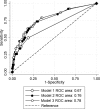Antibiotic exposure as a risk factor for fluconazole-resistant Candida bloodstream infection
- PMID: 22314534
- PMCID: PMC3346668
- DOI: 10.1128/AAC.05947-11
Antibiotic exposure as a risk factor for fluconazole-resistant Candida bloodstream infection
Abstract
Recent exposure to azoles is an important risk factor for infection with fluconazole-resistant Candida spp., but little is known about the role of antibacterial drug exposure in the emergence of drug-resistant Candida. We did a prospective nationwide surveillance study of candidemia in Israel and analyzed the propensity score-adjusted association between antifungal and antibacterial drug exposure and bloodstream infection with C. glabrata and fluconazole-resistant Candida isolates. Four hundred forty-four episodes of candidemia (450 Candida isolates, 69 [15%] C. glabrata isolates, and 38 [8.5%] fluconazole-resistant isolates) from 18 medical centers in Israel were included. C. glabrata bloodstream infection was strongly associated with recent metronidazole exposure (odds ratio [OR], 3.2; P < 0.001). Infection with a fluconazole-resistant isolate was associated with exposure to carbapenems, trimethoprim-sulfamethoxazole, clindamycin, and colistin (odds ratio, 2.8; P = 0.01). The inclusion of antibacterial drug exposure in a multivariable model significantly enhanced the model's predictive accuracy for fluconazole-resistant Candida bloodstream infection. Our findings may be relevant to the selection of empirical antifungal treatment and broaden the scope of antibiotic-associated collateral damage.
Figures


References
-
- Afeltra J, Verweij PE. 2003. Antifungal activity of nonantifungal drugs. Eur. J. Clin. Microbiol. Infect. Dis. 22:397–407 - PubMed
-
- Beggs WH. 1982. Combined activity of ketoconazole and sulphamethoxazole against Candida albicans J. Antimicrob. Chemother. 10:539–541 - PubMed
-
- Chang MR, Cury AE. 1998. Amphotericin B-metronidazole combination against Candida spp. Rev. Iberoam. Micol. 15:78–80 - PubMed
-
- Charlson ME, Pompei P, Ales KL, MacKenzie CR. 1987. A new method of classifying prognostic comorbidity in longitudinal studies: development and validation. J. Chronic Dis. 40:373–383 - PubMed
-
- Cole GT, Halawa AA, Anaissie EJ. 1996. The role of the gastrointestinal tract in hematogenous candidiasis: from the laboratory to the bedside. Clin. Infect. Dis. 22(Suppl. 2):S73–S88 - PubMed
Publication types
MeSH terms
Substances
LinkOut - more resources
Full Text Sources
Other Literature Sources
Medical
Miscellaneous

